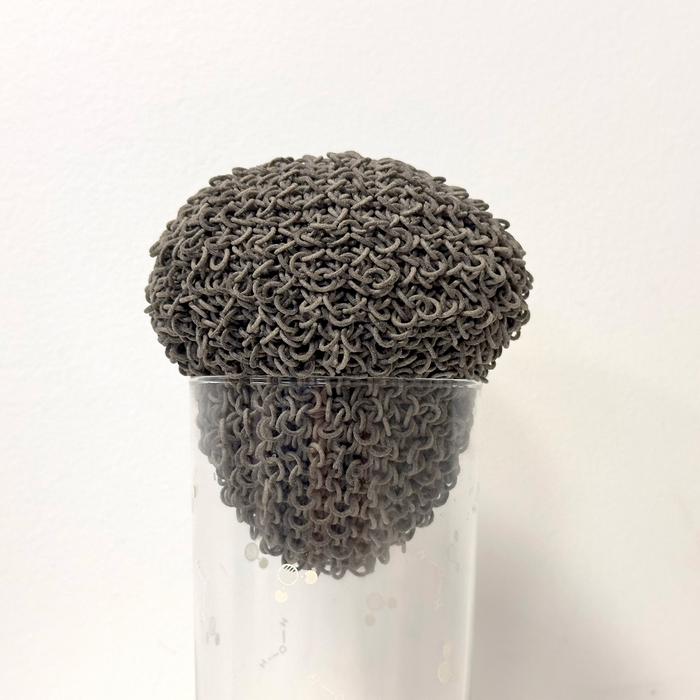In an exciting breakthrough in material science, researchers at Caltech have developed a groundbreaking type of matter known as polycatenated architected materials, or PAMs. Unlike conventional materials that exist either as granular or crystalline structures, PAMs uniquely exhibit properties of both. This innovative material responds to various physical stresses like a fluid in some scenarios while acting like a solid in others. This remarkable versatility holds immense promise for applications ranging from protective gear to biomedical devices and soft robotics.
PAMs are fundamentally distinct from the materials we usually encounter. While traditional materials can be differentiated as either solids or granular substances, PAMs transcend this duality. They can be likened to ancient technologies like chain mail, which consist of interlinked rings providing flexibility and resilience. However, PAMs take this concept to an entirely new level by utilizing advanced 3D printing techniques to produce materials that are light, multifunctional, and adaptable. These materials comprise intricate patterns of interlaced shapes that vary widely, resulting in unique behaviors that confound conventional material classifications.
In the pursuit of understanding PAMs, researchers in Chiara Daraio’s lab have explored the behavior of these materials through rigorous experimental methodologies. Using state-of-the-art 3D printing, they constructed PAM prototypes based on meticulous computer models that simulate lattice structures typically observed in crystals. However, the stark difference lies in their composition, as these prototypes utilize interconnected rings or cages that are free to move relative to one another, enabling a fluid-like response under certain stress conditions.
The research team, led by postdoctoral researcher Wenjie Zhou, subjected various PAM prototypes to a series of stress tests, including compression, shear forces, and twisting movements. Zhou’s findings revealed that PAMs behave intriguingly under stress—at times flowing like liquids when shearing forces are applied, while exhibiting solid-like rigidity when compressed. This dynamic behavior underscores the materials’ potential utility in fields requiring energy absorption and impact resistance, particularly in protective gear.
Notably, PAMs are not merely academic curiosities; they represent a significant advancement in the engineering of materials. Researchers have identified a broad spectrum of potential applications leveraging the materials’ properties. For instance, the energy-dissipation capabilities of PAMs could revolutionize the design of safety helmets or cushioning for various devices. Engineering these materials could lead to safer, more effective protective solutions compared to traditional foams, which often lack the same adaptive qualities.
Moreover, the ability of PAMs to respond to electrical charges and physical forces offers tantalizing possibilities in biomedical applications and soft robotics. Their unique structure allows for expansions or contractions in response to stimuli, potentially paving the way for innovative biomedical devices that can adjust to their environment or to patients’ needs. This adaptability is particularly vital in an era where the integration of technology into healthcare is becoming increasingly prevalent.
The research into PAMs is poised on the cutting edge of material science, tapping into insights from decades of work in architected materials while also carving out a novel frontier. Chiara Daraio highlighted that while theories exist to understand granular and elastic materials, there is still much to learn about these hybrid structures. The study of PAMs opens the door for interdisciplinary approaches that blend engineering, physics, and materials science to explore this new paradigm.
The implications of PAM research are vast, and researchers envision exciting developments on the horizon. One key area of interest is the integration of artificial intelligence in the exploration and design of PAMs. The design space is vast and largely uncharted, and employing AI could significantly expedite the process of discovering new PAM configurations and applications.
As the proprietary research continues to unfold, the excitement surrounding PAMs is palpable. Various stakeholders, including military and medical sectors, are keeping a keen eye on these developments, eager to see how they can harness the unique properties of PAMs for practical use. This work not only represents a leap in theoretical understanding but also a tangible step toward real-world applications that could transform existing paradigms.
In conclusion, the development of polycatenated architected materials by the Caltech research team signifies a transformative moment in material science. The blend of unique properties challenging traditional distinctions between solid and fluid states may herald a new age of materials capable of adaptive behavior, yielding novel solutions across diverse fields. As studies progress, the journey of PAMs promises to unveil more secrets and potentials that are yet to be imagined, perhaps redefining how we approach material engineering in the future.
Understanding and manipulating the transition between fluid and solid states in PAMs will contribute not just to academic advancements but also beneficial transformations in practical applications. The amalgamation of robust mechanics with lightweight adaptability creates a pathway to innovate countless industries, all while inspiring future generations of scientists and engineers to push the boundaries of what materials can achieve.
As we look ahead, the research team stands at the forefront of material science, with their work published in the prestigious journal Science set to be one of many entries in what promises to be a continuously evolving narrative around PAMs and their unique functionalities. Excitement is building, and the door to incredible new advancements swings wide open.
Subject of Research: 3D Poly-Catenated Architected Materials
Article Title: 3D Poly-Catenated Architected Materials
News Publication Date: 17-Jan-2025
Web References: DOI: 10.1126/science.adr9713
References: None provided
Image Credits: Credit: Wenjie Zhou
Keywords
Materials science, PAMs, adaptive materials, protective gear, biomedical devices, soft robotics, energy absorption, 3D printing, engineering, material engineering.
Tags: 3D printingadaptive materialsarchitected materialsbiomedical devicesenergy absorptionfluid-solid hybridmaterial innovationmaterials sciencePAMsprotective gearsoft roboticsstructural adaptability





